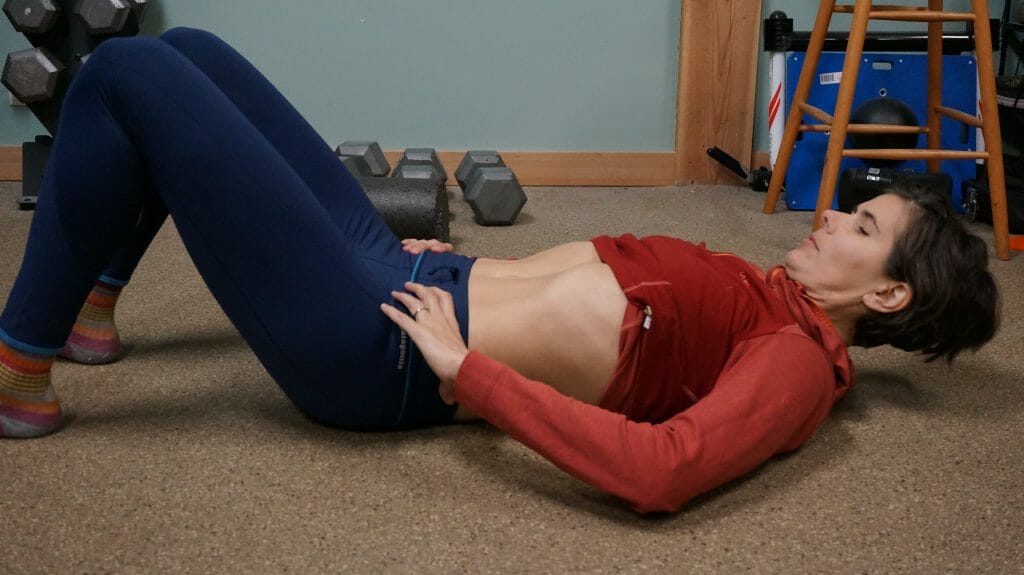After you deliver a baby, it often takes time and effort to bring muscle tone and neuromuscular pathways back online for the pelvic floor. As with any well-structured and progressive training, don’t compare what you can do with what you see others doing. It’s much more important to start from where you are, and progress from there. The goal of the following beginning postpartum core exercises is to get your diaphragm, TA, and pelvic floor muscles working together again. Because of that, you can do this workout multiple times per week. It shouldn’t make you feel sore so much as more connected to muscles you may have forgotten about.
If you haven’t already, read Returning to Training after Pregnancy: Foundation for a Strong Core to learn the musculature we’re talking about when we say “core.”
Posture: Finding Neutral
In order to engage the correct muscles, you must first find and maintain good posture. This is just as important as the exercises themselves. Your spine, pelvis, and ribcage are all positioned in relation to each other. For example, if your pelvis tends to tip forward, your spine will curve, and your ribcage will tip backward to balance you out so you don’t fall over. We all have postural habits and movement patterns that we develop over our entire lifetimes, so don’t fret if it’s challenging to hold the following exercises. Just know that you’ll be able to engage your core most effectively when your spine, pelvis, and ribcage are “neutral.”
“Neutral” means that if the pelvis is a bowl full of water, the water doesn’t spill out the front or from either side. The ribcage is like an upside-down bowl, so the same applies: the front ribs should ideally be in line with your pelvis, not flaring out. This eases the muscles of the low back and allows the spine to also be in a neutral position. This is your starting point for each exercise and, really, should guide how to position yourself throughout the day.
The nature of creating space for a growing baby and carrying more weight within the abdominal space usually results in a shortening of the back muscles (thereby creating more of a curve in the low back by tilting the ribcage back and the hips forward). As pregnancy progresses and the baby grows, this becomes more and more of an issue. Additionally, as the baby grows it also pushes into the diaphragm, making breathing more difficult. You’ll know from the preceding article that this causes the core to become detached from the normal breathing mechanism. Since you may not have even noticed this shift in postural alignment over the course of the last 10 or more months, start by standing with a mirror to your side, and look at how your ribcage relates to your pelvis. Check that your knees aren’t locked, and that your pelvis is in a neutral position. Imagine headlights on your front hip bones: where are the lights pointing? Once you can find your supported posture, we can begin some basic exercises.

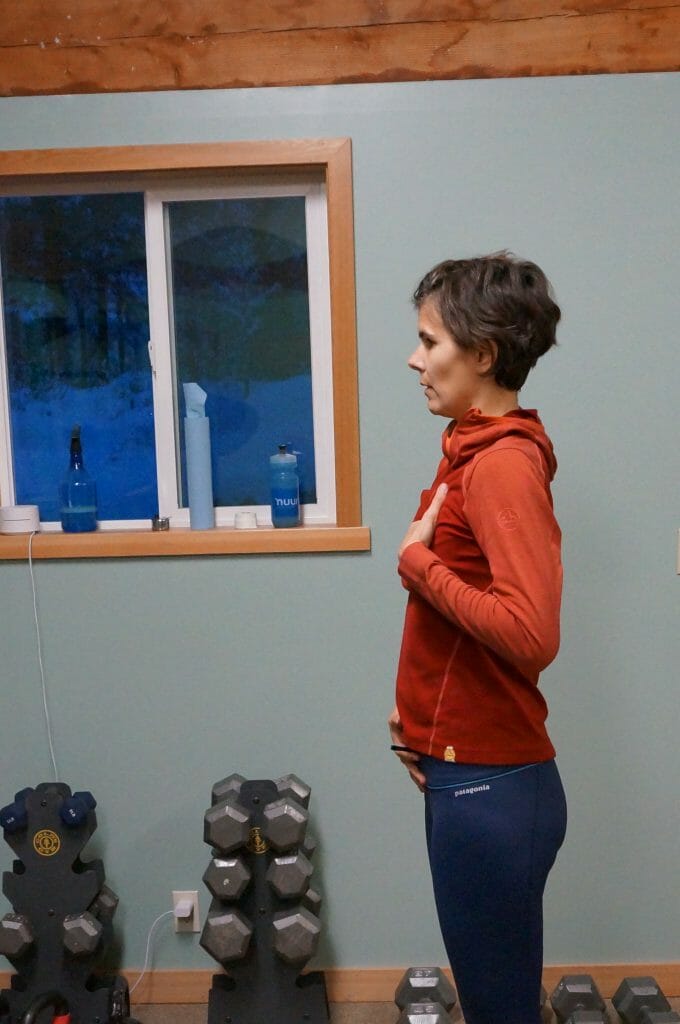
Beginning Postpartum Core Exercise Progression
The simple, gentle exercise progression described here will help you reengage those deeper core muscles you may have lost touch with while pregnant.
The Bread Loaf
Many years ago I worked as an aide at a local PT clinic, where my women’s health specialist PT friend introduced me to the important but dreaded concept of the bread loaf. When the TA is either overloaded (i.e., the exercise is too hard) or on vacation, the trusty RA comes in to help. As a result, the muscle belly pops up in response, creating what looks like a bread loaf atop your stomach. This helpful but slightly horrendous metaphor is an instant indicator that your spine isn’t protected. For these and any core exercises, if your stomach turns into a bread loaf, you need to stop, reengage your TA, and lessen the range of motion and/or shorten the lever you’re moving.

Breathing
OK, now we’re ready to get started. The first “exercise” is to connect your breath to your pelvic floor and TA. Lie on your back with your knees up and feet on the floor (called “hook lying”). Check your ribcage and pelvis to see that your back isn’t arching and your pelvis isn’t dumping forward or tipping back. Now, put your hands on each side of the top of your pelvis, the ilia, and start paying attention to your breath.
As you exhale, draw up your pelvic floor muscles (as if you’re stopping the flow of urine), which will automatically engage your TA. You should feel this engagement under your hands, as if your hip bones are drawing closer to each other, or you’re zipping up a tight jacket. We’re looking for muscular control here, not clenching. As you inhale, relax your deeper muscles while still maintaining proper structural alignment.
Do 10 breaths.
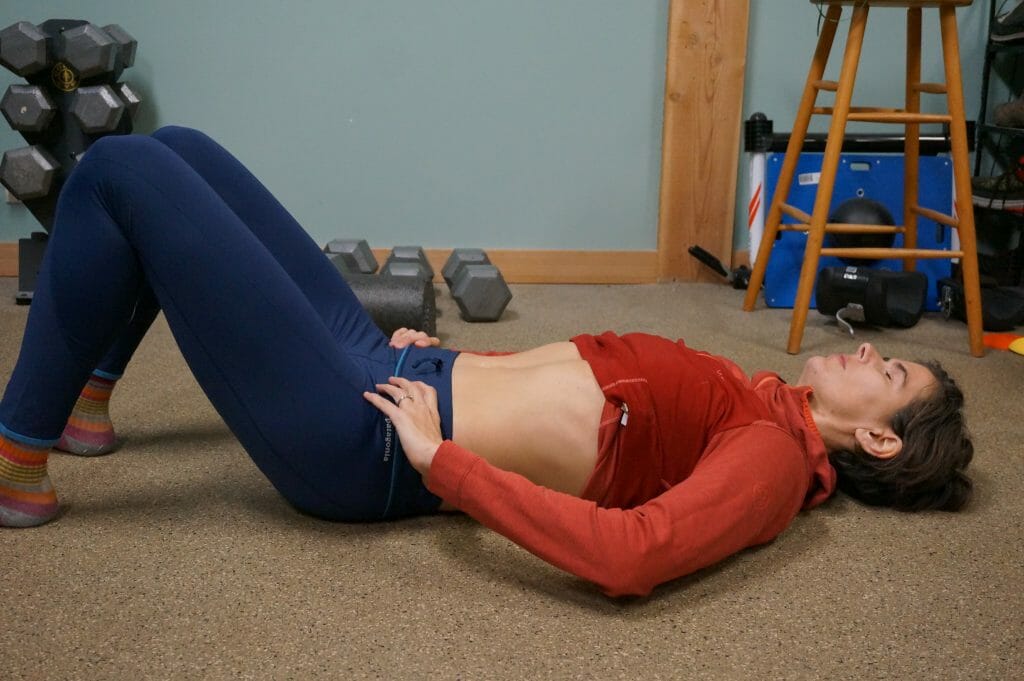
Hip Bridging
Start in the same “hook lying” position and take a breath or two to ensure good core engagement. As you exhale, keep your pelvis stable while raising your hips. Hold at the top for one full breath cycle and then slowly lower to the floor. This is an exercise that reveals your postural patterns. If you get to a point where you either lose your core engagement or your ribcage flares out, readjust to engage the core, or lower back down and try again. If you have trouble feeling your core, place a yoga block or foam roller between your knees and squeeze your knees together as you lift. You should feel your glutes for this as well; if your hamstrings cramp, squeeze your glutes more.
Do 10 reps with a full breath at the top.

Bent Knee Fallout
The next step is to maintain the same connection with your breath while introducing some gentle appendicular movement. Start in hook lying and connect your breath to your core. On an inhale, once you feel good core and pelvic engagement, drop one bent knee out laterally toward the floor. Only go as far as you can while still engaging your core. This might only be one inch, which is fine. Over time you’ll be able to get a larger range of motion. Exhale to bring your knee back, then switch legs.
Do 10 on each side, alternating side to side.
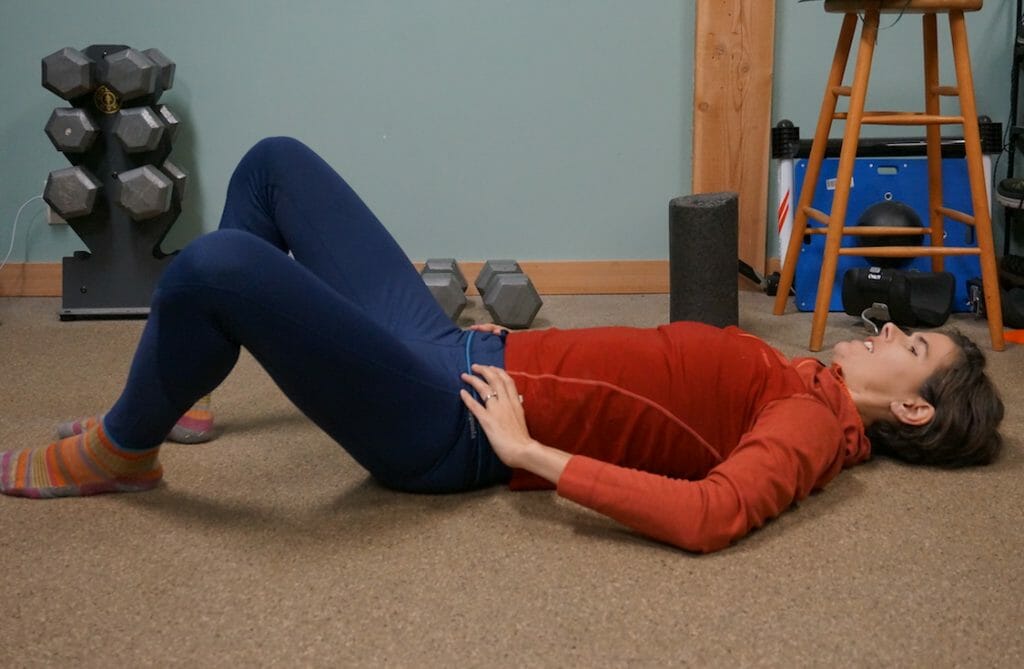
Marching
Begin in the same position as the previous exercise. When you feel good core and pelvic engagement, bring one knee up, lifting the heel from the floor. As you inhale, lower the leg back down. On the next exhale, lift the other knee, and so on. Like the previous exercise, only do as much range of motion as you can while maintaining core connection and pelvic stability. If you lose the core, you’ll feel your pelvis shift side to side.
Do 10 on each side, alternating side to side.
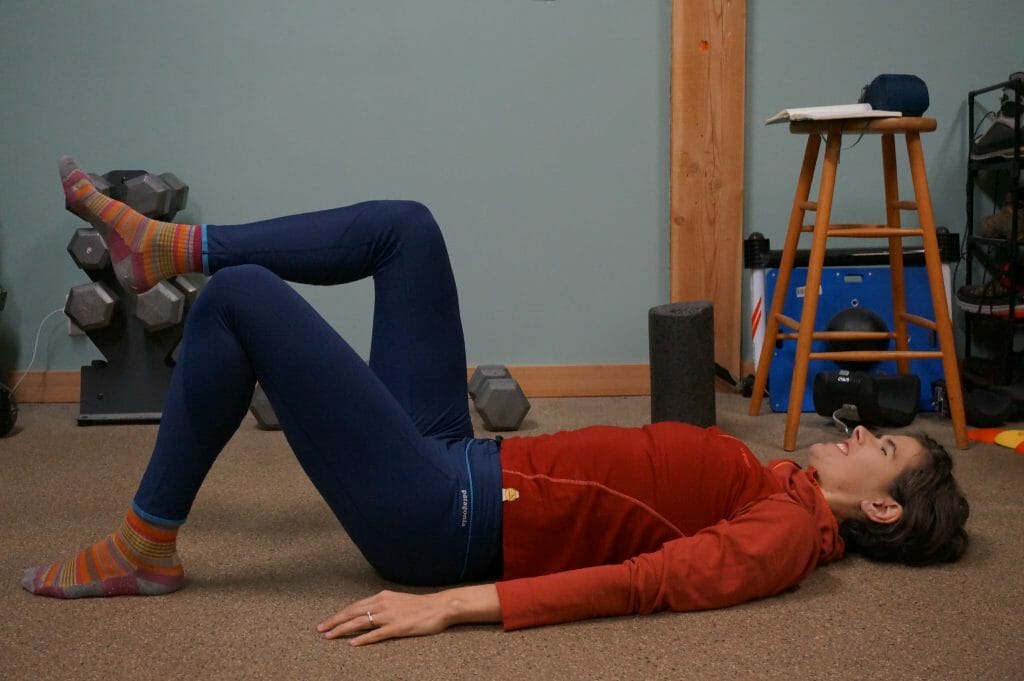
Next Steps
These beginning postpartum core exercises might not feel like much, but remember that the goal is to rebuild the correct foundational support for proper function. You recently had a baby; focusing on your core will allow you to return to doing harder, more sport-specific strength and movement safely, without putting your body at risk of injury. Continue doing these daily or every other day until you can do them easily—with no bread loaf! In addition, try to find neutral in other positions throughout the day.
Further Reading
- “The Effects of Deep Abdominal Muscle Strengthening Exercises on Respiratory Function and Lumbar Stability”
- The diaphragm—a deep dive
- “Patterns within the abdominal muscle wall in postnatal women”
- The Female Pelvis Anatomy and Exercises, by Blandine Calais-Germain
- Anatomy of Breathing, by Blandine Calais-Germain
DISCLAIMER
This article is for general information and not medical advice. It’s important to discuss your return to activity with your doctor. Every woman and pregnancy is unique and should be respected as such. If you have a more serious condition like diastasis recti, I highly recommend working with a PT who specializes in women’s health and postpartum wellness.

